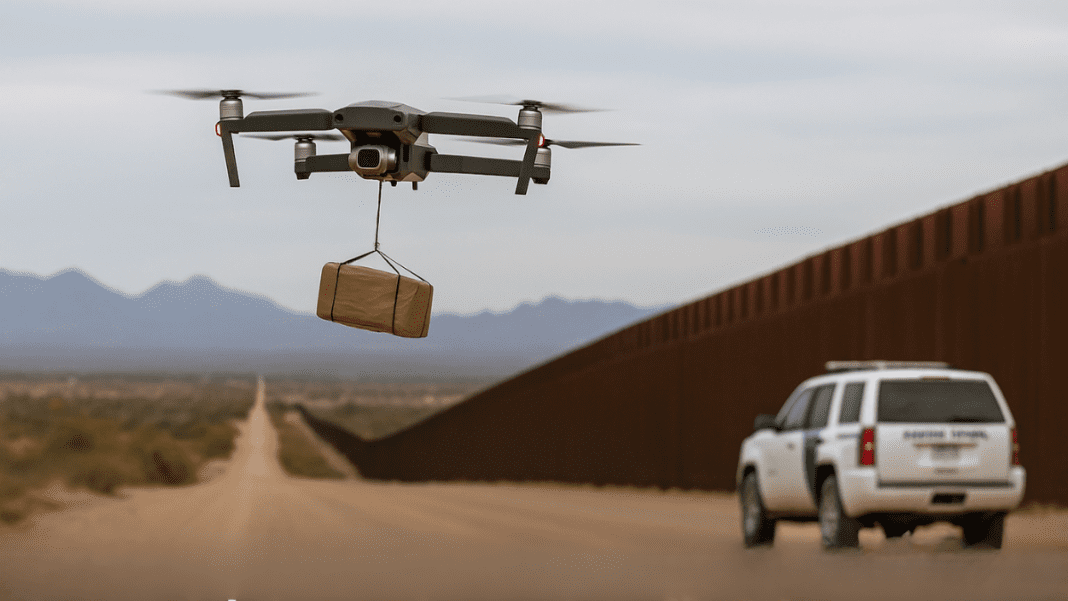Arizona Attorney General Kris Mayes has sounded the alarm over a growing threat at the southern border — drones being used by Mexican drug cartels to deliver deadly fentanyl into the United States.
Drones Smuggle Drugs Across Arizona Border, Official Says
According to Mayes, although illegal border crossings by people have dropped, the danger has not disappeared. In fact, it has taken to the skies.
“I think what has changed is that we have gotten more control over people crossing over the border,” Mayes said. “But unfortunately what has not changed is we still have a huge amount of fentanyl that is coming across our border here in Arizona. That is being flown over by the Mexican drug cartels with drones.”
Drones are small, fast, and easy to operate remotely. Criminal groups use them to carry illegal packages from Mexico into Arizona without setting foot on American soil. These drones can travel through remote desert areas, flying low and avoiding radar, making them difficult for law enforcement to detect.
Chávez Jr. Arrest Rocks Culiacán as Cartel Allegations Surface—Legendary Boxing Legacy in Jeopardy
Fentanyl is a powerful synthetic opioid that has caused a major health crisis in the U.S. A small amount — just two milligrams — can be deadly. Arizona, a border state, continues to see large quantities of this drug flowing in through high-tech smuggling methods. Authorities now face a new and risky dilemma as a result of the deployment of drones to carry these substances.
Bipartisan Law Targets Drug-Smuggling Drones
To address this rising threat, Arizona lawmakers passed a new bipartisan law allowing law enforcement to shoot down drones suspected of being used by cartels. The law provides specific authority to disable these aircraft when they are believed to be transporting illegal substances across the border.
This law was enacted in response to increasing reports of drone activity near the U.S.-Mexico border. Previously, officers had limited options to act if they spotted a drone carrying drugs. Now, they can take immediate action to stop these flying machines before they drop their deadly cargo.
Support for the measure has come from both major parties. It reflects a shared understanding that technology is changing how drugs are moved, and that authorities need modern tools to keep up. The use of drones for drug smuggling is particularly dangerous because it removes the need for human couriers and allows cartels to take more risks.
Some drones are capable of carrying several pounds of fentanyl in one flight. With no human involved, these missions are cheaper and less risky for criminal organizations. Law enforcement officials say drones are launched from Mexico, fly across the border carrying the drugs, and drop them at predetermined locations. The medicines are then transported and dispersed throughout the United States.
Arizona Remains a Fentanyl Hotspot
Arizona has long been a key entry point for drug smuggling due to its geography. The state’s vast deserts and remote stretches of land make it harder for authorities to maintain constant surveillance. Drones take advantage of these gaps in security, often flying at night or in low-visibility conditions.
Even with tighter controls at official border crossings, the drug flow continues. Cartels have simply changed their strategy — replacing smuggling tunnels and hidden compartments in vehicles with airborne delivery systems.
Attorney General Mayes emphasized that while human trafficking may have declined, drug trafficking has adapted. “We’re not seeing as many people crossing, but the fentanyl is still coming,” she said. “And the cartels are now using drones to make that happen.”
🧬 Forensic Nightmare: 20 Dead, No IDs—Mexico Struggles to Keep Pace With Cartel Killings
Officials also worry about the safety risks drones pose beyond just drug trafficking. Some drones have flown near public areas or government facilities, raising alarms about what else they could be used for. There have been incidents where drones crashed or dropped packages in neighborhoods, posing danger to civilians.
Arizona’s new law is an attempt to counter this evolving threat. But the challenge remains serious. Drug cartels are constantly changing tactics to avoid detection, and drones have given them a powerful new tool.
The situation highlights how modern technology is shaping the illegal drug trade and creating new problems for border security. As drones become cheaper and more advanced, law enforcement agencies across the country may need to adapt to fight this airborne threat.

